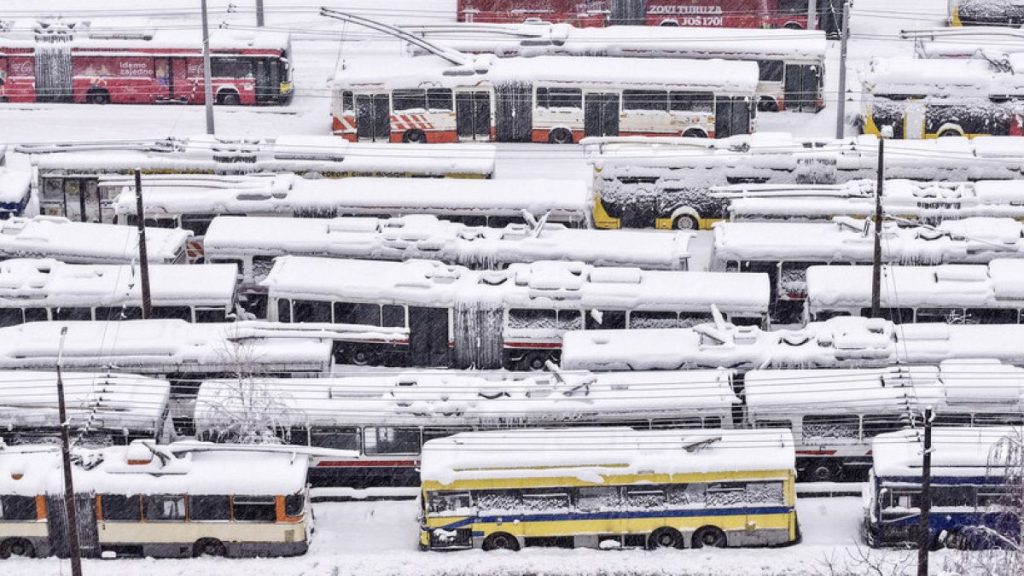The Balkan region is currently grappling with the widespread disruption caused by a series of severe snowstorms that have blanketed the area in heavy snow, cutting off power to tens of thousands of homes and severely impacting transportation networks. Countries including Bosnia, Croatia, Slovenia, Serbia, Kosovo, Montenegro, and North Macedonia are all facing significant challenges as they struggle to cope with the intense snowfall and its cascading effects. The heavy snow has made travel treacherous, if not impossible in some areas, leading to widespread closures of highways and railroads, stranding travelers and disrupting supply chains. Emergency services are working tirelessly to restore essential services and provide aid to affected communities, but the ongoing snowfall and difficult terrain are hampering their efforts.
Bosnia has been particularly hard hit, with the northwestern and western regions bearing the brunt of the storm’s fury. Over 200,000 homes in these areas have been left without power, compounding the challenges posed by the heavy snowfall. The loss of electricity has also disrupted heating and water services, leaving residents vulnerable to the freezing temperatures. The ongoing snowfall and treacherous road conditions are proving to be major obstacles for relief efforts, prompting many local districts and regions to declare a state of emergency. Towns like Dvar and Bosanski Petrovac have been completely cut off from the outside world, buried under more than 80 centimeters of snow, further isolating residents and hindering access for emergency responders.
The widespread closures of businesses, schools, and other civilian facilities across Bosnia underscore the extent of the disruption caused by the severe weather. The heavy snow has brought daily life to a standstill, trapping motorists on snow-covered roads for over 12 hours in some instances. Regional governments are working frantically to clear the roads and address the growing crisis, but the persistent snowfall continues to pose significant challenges. The sheer volume of snow, coupled with the difficult terrain, is making it a herculean task to restore access and provide much-needed aid to affected communities.
Croatia is also facing significant difficulties as the heavy snow and strong winds create hazardous conditions on roads and coastal areas. Traffic has been severely disrupted, particularly in Gorski Kotar, Lika, and Slavonia, where heavy snow has made travel extremely difficult. The authorities have implemented a ban on heavy vehicles to minimize the risk of accidents and further congestion. Along the coast, strong bora winds are creating challenging conditions, disrupting ferry services and impacting maritime activities. While the winds temporarily weakened, allowing for the resumption of some ferry services, forecasts predict a return of stronger winds, raising concerns about further disruptions and potential damage.
Across the Balkan region, travel warnings are in effect as snow drifts and hazardous conditions force the closure of major routes. Authorities are urging citizens to avoid all non-essential travel and stay home to minimize the risks associated with the severe weather. The combination of heavy snow, strong winds, and treacherous road conditions has created a dangerous situation, and officials are emphasizing the importance of prioritizing safety. The ongoing snowstorms are a stark reminder of the region’s vulnerability to extreme weather events and the need for robust preparedness and response mechanisms.
The widespread disruption caused by these severe snowstorms highlights the interconnectedness of essential services and the vulnerability of communities when these services are disrupted. The loss of power, coupled with the disruption of transportation networks, has created a complex and challenging situation for the affected countries. The ongoing efforts of emergency responders and government agencies are crucial in addressing the immediate needs of affected communities and working towards restoring essential services. However, the continued snowfall and difficult conditions underscore the need for long-term planning and investment in infrastructure to enhance resilience to future extreme weather events.

